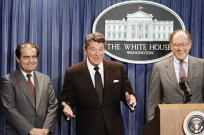Originalism and Judge Neil Gorsuch
At the annual Originalism Works in Progress Conference, I try to discuss, at the beginning of the conference, the most important events concerning originalism in the past year. Here is an excerpt of my remarks on Supreme Court nominee Judge Neil Gorsuch:
Last year, I spoke about the sad passing of Justice Scalia and whether originalism could survive it. But what a difference a year makes! Based on his writings, it appears that Judge Neil Gorsuch would be an originalist justice. Some of the strongest evidence of Gorsuch’s originalism comes from his Case Western Law Review Article on Justice Scalia.
That essay suggests that not only does he seem to be an originalist, but the type of originalist who is near and dear to my heart. First, Judge Gorsuch appears to be a public meaning originalist, advocating that judges look “to text, structure, and history to decide what a reasonable reader at the time of the events in question would have understood the law to be.”
Significantly, Judge Gorsuch roots originalism in the separation of legislative from judicial power. Gorsuch writes: While “legislators may appeal to their own moral convictions and to claims about social utility to reshape the law . . . , judges should apply the law as it is, focusing backward, not forward.”
Judge Gorsuch take the separation of power very seriously in a way that is not all that common today. For example, he asks if judges were free to legislate, “why would [the founders] have gone to such trouble” to impose bicameralism and presentment “only to entrust judges to perform the same essential function without similar safeguards?”
Judge Gorsuch views the separation of powers as “among the most important liberty protecting devices of the constitutional design.” He illustrates the problems for liberty from combining powers through the example of a Mexican immigrant who was harmed by the Board of Immigration Appeals. In colorful language that echoes Justice Scalia’s pen, Gorsuch writes:
So that, quite literally, an executive agency, acting in a faux-judicial proceeding, and exercising delegated legislative authority, purported to overrule an existing judicial declaration about the meaning of existing law, and apply its new legislative rule retroactively to already completed conduct. Just describing what happened here might be enough to make James Madison’s head spin.
This language, combined with Judge Gorsuch’s criticism of the Chevron case, suggests that he may be an originalist critic of expansive executive power.
I could go on, but let me limit myself to one more point. Critics of originalism often emphasize the indeterminancy of the law – as do, I might add, even some friends of originalism. But Judge Gorsuch argues that the indeterminancy of the law is “wildly exaggerated,” in part because “the traditional tools of legal analysis do a remarkable job of eliminating or reducing indeterminancy.”
How then does such indeterminancy get resolved? I was especially happy to read Judge Gorsuch’s argument, which appears to endorse something like what John McGinnis and I refer to as the 51/49 rule. He writes:
At the end of the day, we may not be able to claim confidence that there’s a certain and single right answer to every case, but there’s no reason why we cannot make our best judgment depending on (and only on) conventional legal materials. . . . No reason, too, why we cannot conclude for ourselves that one side has the better of it, even if by a nose, and even while admitting that a disagreeing colleague could see it the other way.
I could not have said it better myself.
Of course, there are no assurances with Supreme Court appointments, especially by Republicans. So we probably won’t know anything with confidence for a few more years. But the prospects of originalism at the Supreme Court seem much more promising today than they did a year ago.
